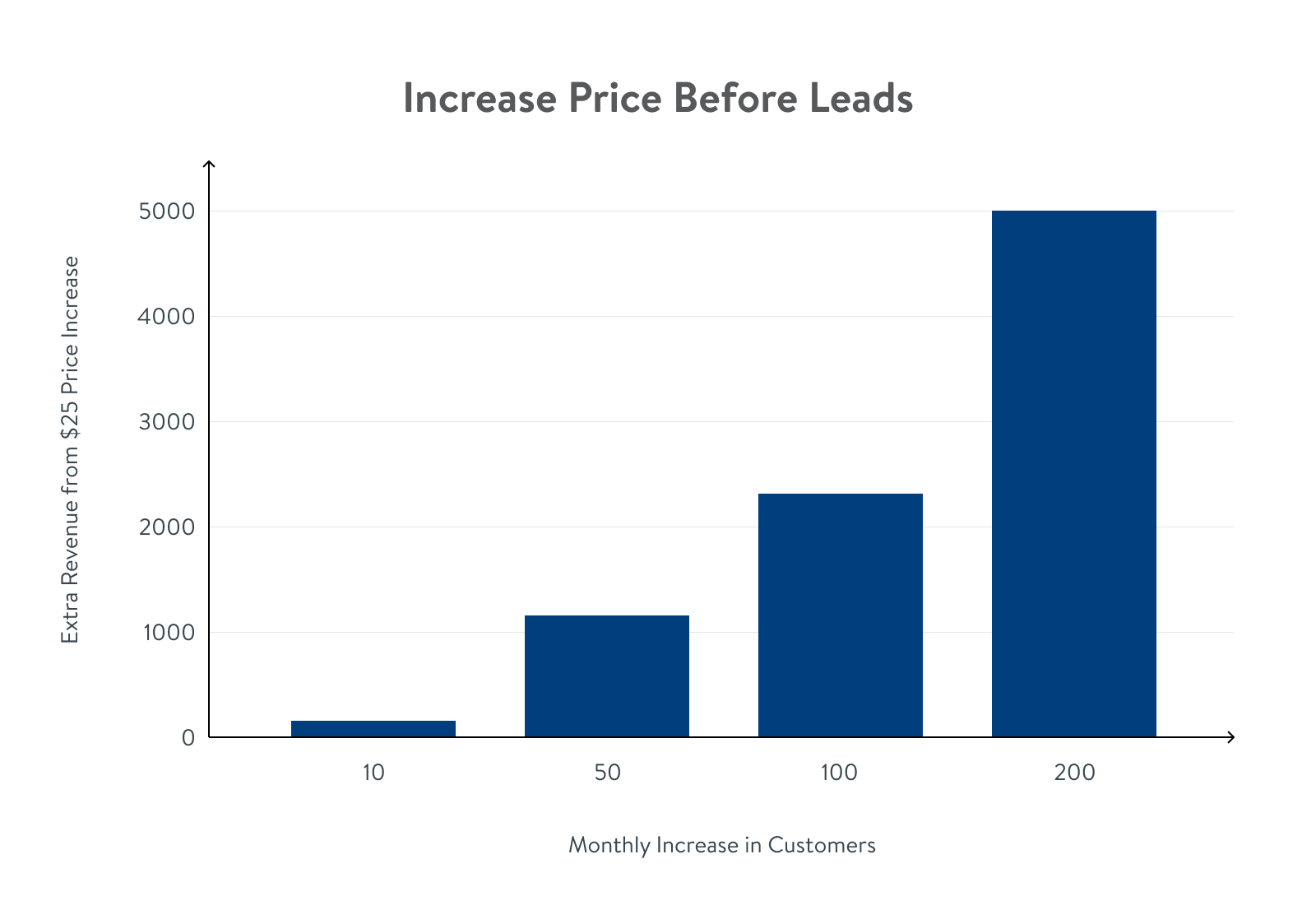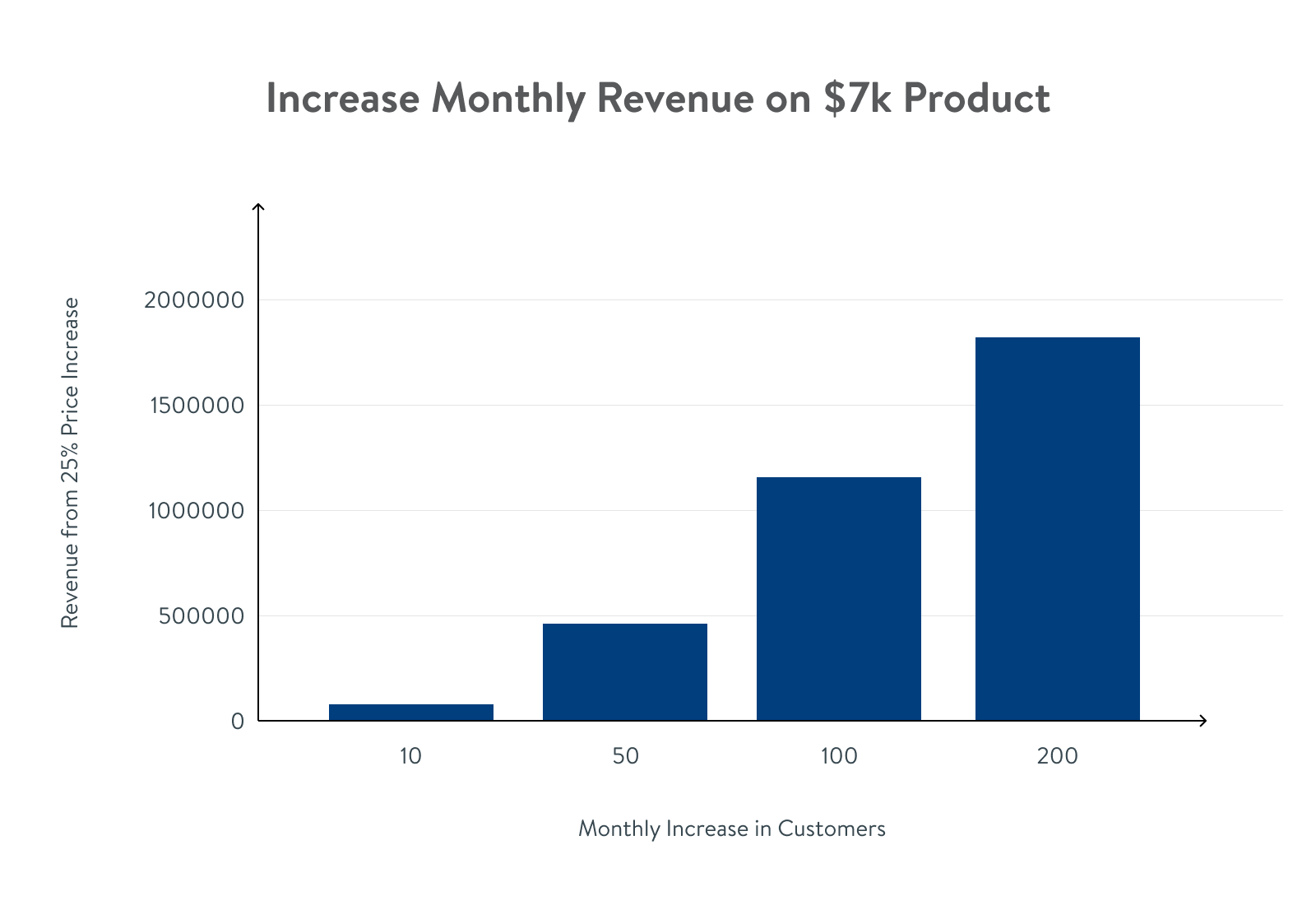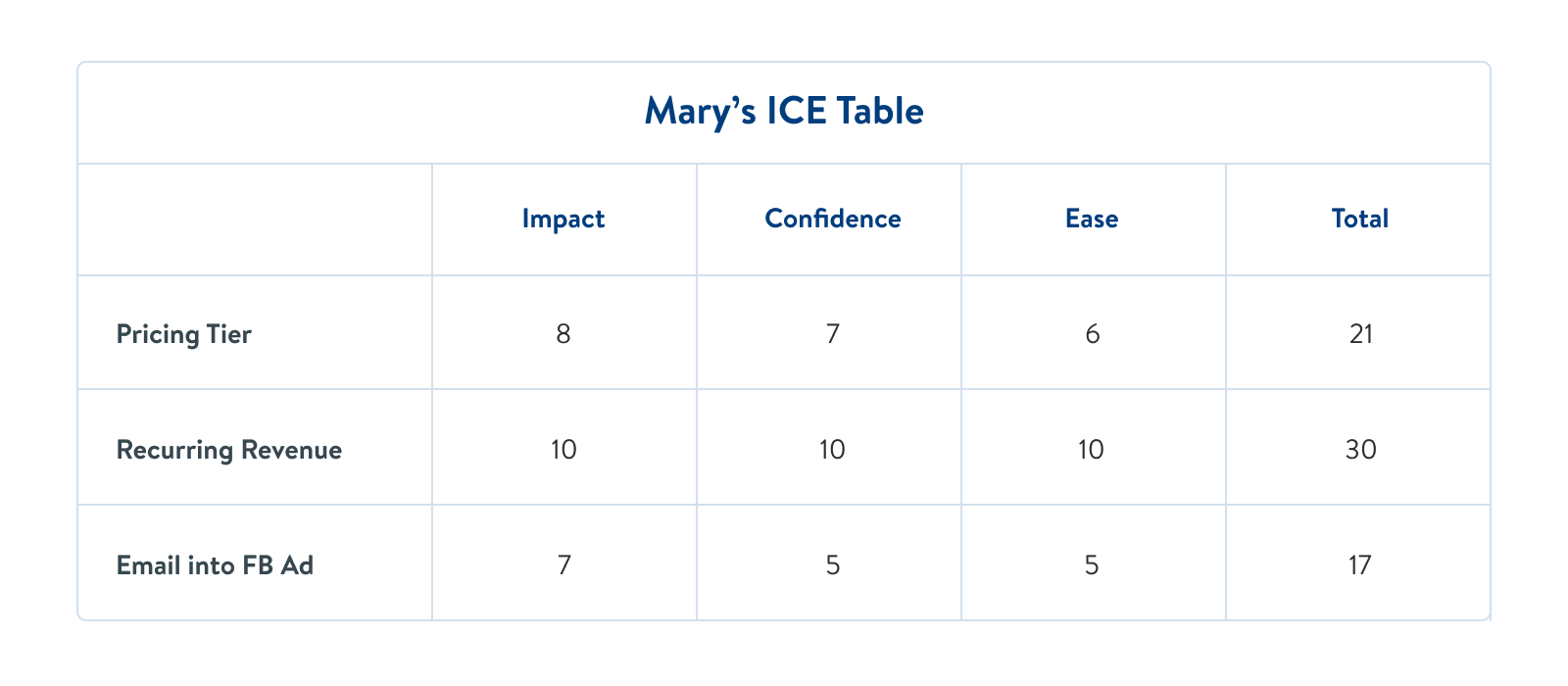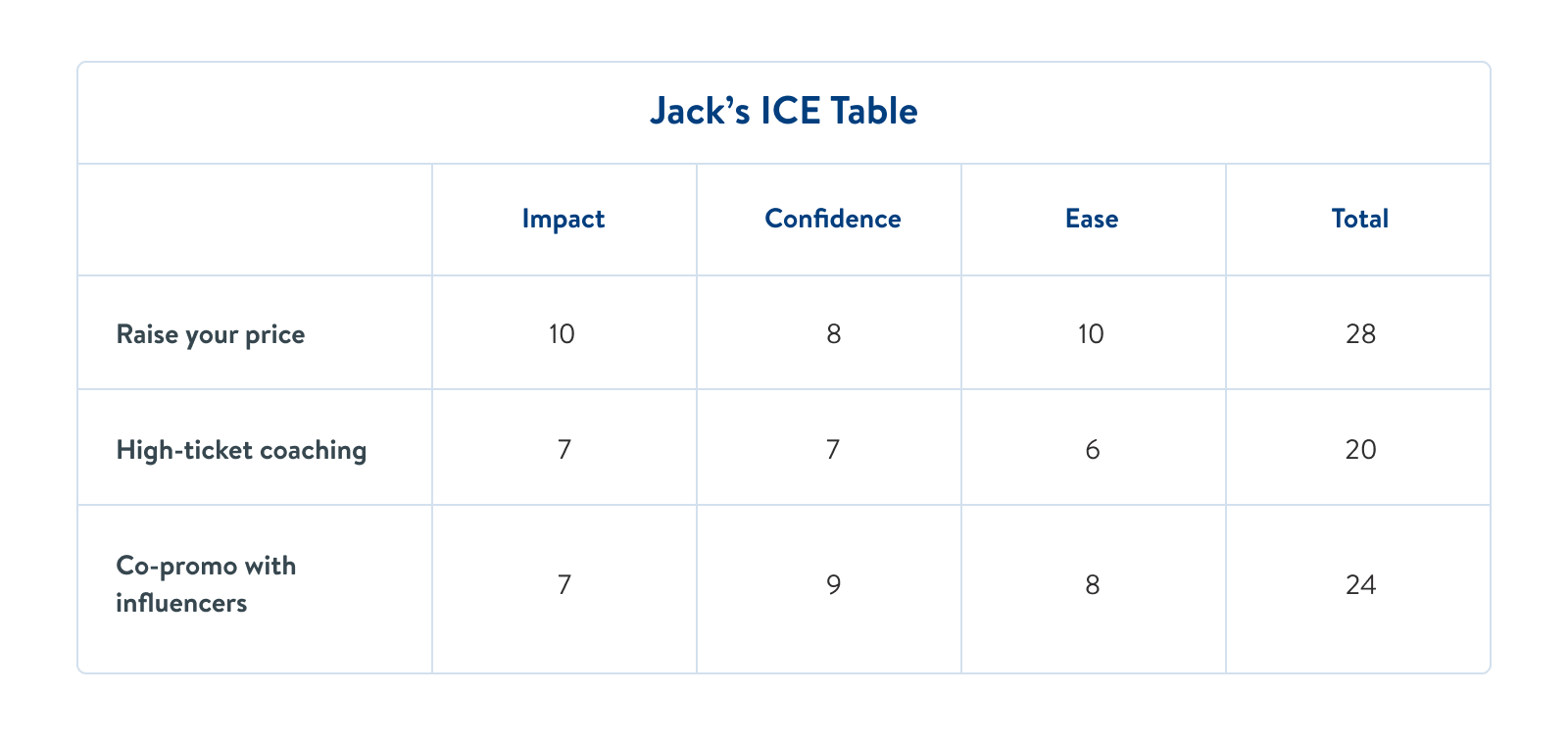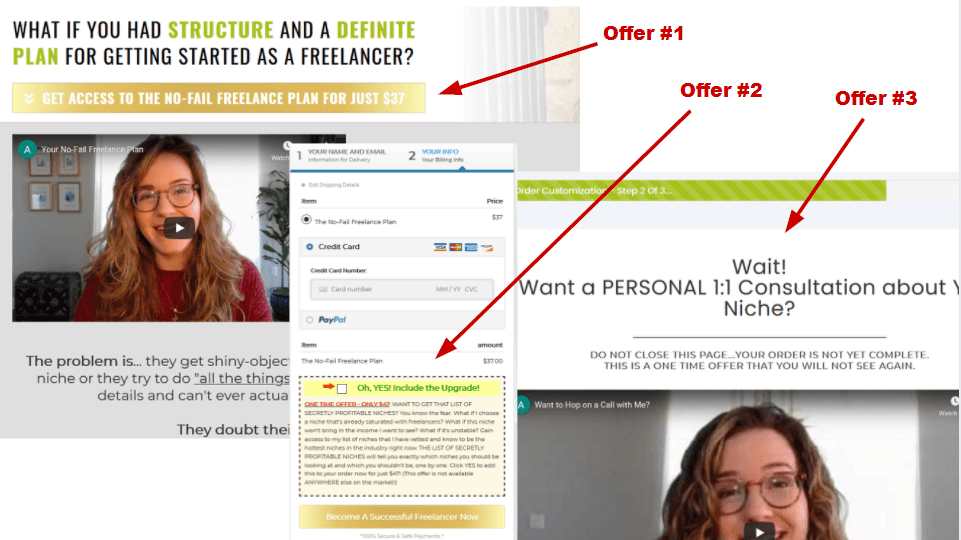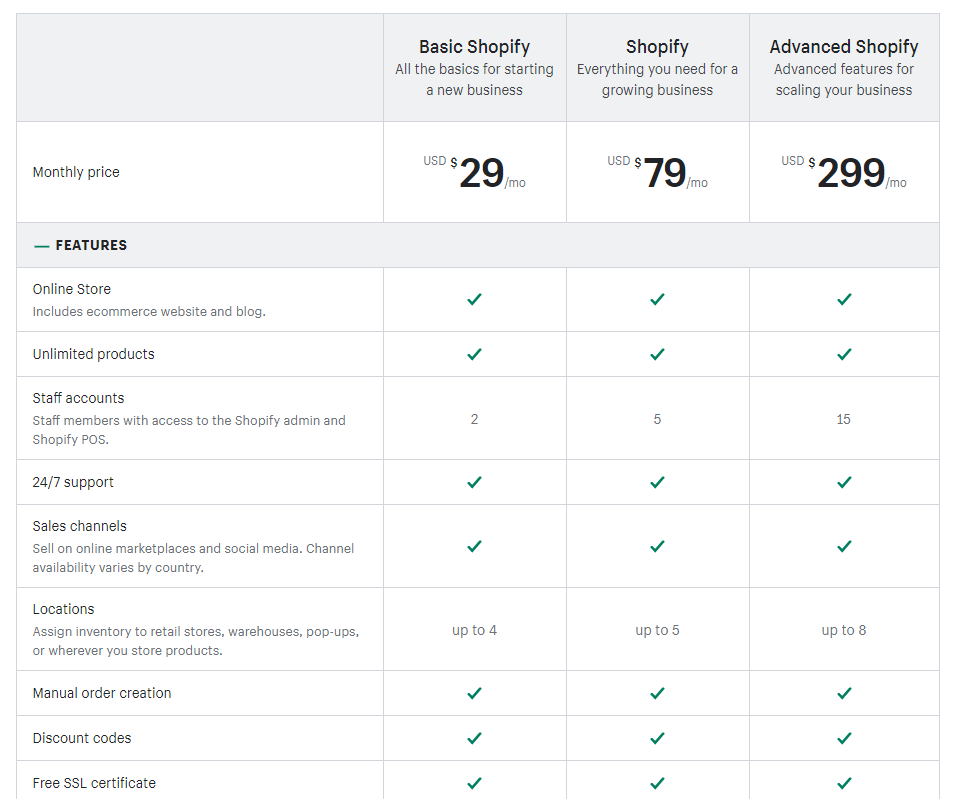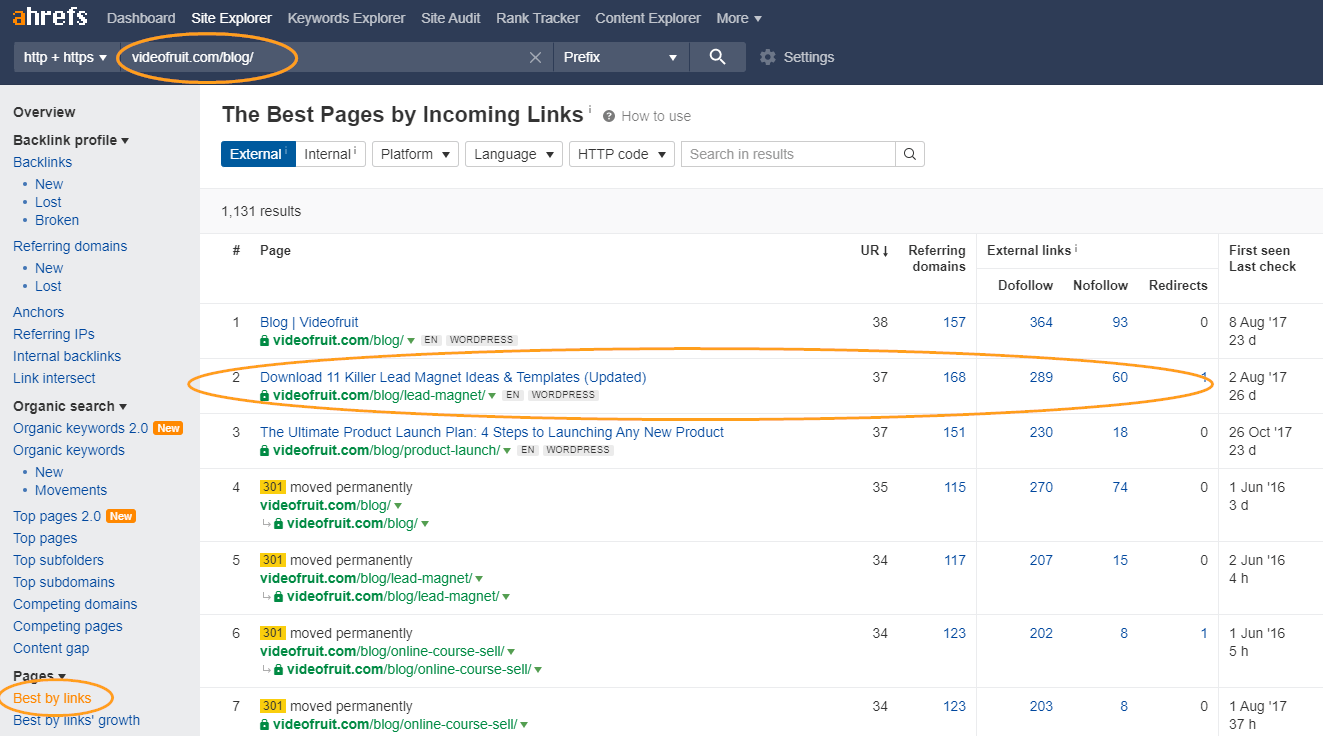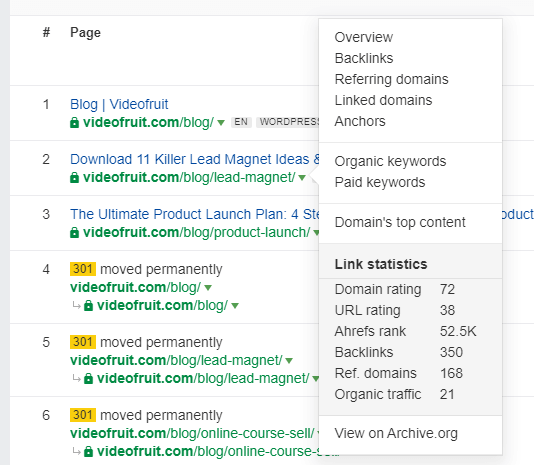People chase tactic after tactic to grow, but there are really only three ways to grow a business:
- Get more customers.
- Increase the order value.
- Increase buying frequency.
Know which one most people try first? Number 1: get more customers. But that’s actually the hardest way to increase sales revenue.
You can grow your business by 50% to 100% just by increasing your price and buying frequency.
Finding new customers is absolutely important, but it’s far more impactful if you find more customers after your average order value is higher.
This is true for two reasons:
- More customers buying at a higher price = more money, faster.
- You don’t have to “sell” those customers twice (once to become a customer, and again to accept your price increase).
Instead, you up the price first, then avoid the hard work of explaining to all those new clients why you’re raising prices.
Say you offer a product that your clients only purchase once. Would you rather increase leads before price, or price before leads?
Here’s what happens to your revenue from a $100 product if you increase the price to $125 and then start growing leads. If you get 10 new customers per month, it’s only a $250 difference in one month.
But once you get 50 new customers, suddenly that’s a $1,000+ bump to revenue. And at 200 new customers, you’re looking at an extra $5,000 per month.
If you’re selling a high-ticket product or subscription, that difference explodes.
So before you spend another minute tinkering with your social media pages, read through this list of 14 tactics to increase sales and find new customers (grouped into three buckets — order value, buying frequency, and lead gen):
Pick one — the list is roughly in order of importance, so ideally #1 or #2 — to focus on for 90 days. Make your goal at least a 10% increase in whatever category you pick. After those 90 days are up, pick a new one to focus on.
Do that systematically, and big things happen. This process is your action plan to increase sales revenue every 90 days.
One thing before we dive in: Because I work with so many online course creators and coaches, many of the examples I give are based on these kinds of businesses. But most of these tactics are easily adaptable to eCommerce, agency work, and even brick and mortar stores.
Not every idea will work for your business. You’ll have to use common sense and pick the ones you can execute that seem easy and effective for your business. If you’re not sure how to prioritize them, use the ICE framework.
Want help choosing and acting on an action plan to increase sales? Book a complimentary strategy session, where we’ll audit your business strategy and talk through a 90-day plan to skyrocket revenue.
How to Pick the Best Growth Idea for Your Business with the ‘ICE’ Framework
ICE stands for Impact, Confidence, and Ease. It’s a framework for prioritizing what to do first with your business. You can use it with the list of 14 ideas below.
Ask yourself these three questions about any tactic that you’re considering:
- Impact: How impactful could this strategy be for my revenue growth?
- Confidence: How confident am I that this strategy would increase revenue?
- Ease: Given my skills, business model, and resources, how easy would it be to implement this tactic?
For each question, assign a score from one to 10 (with 10 being the highest and one being the lowest), total the scores, and boom: You’ve got your ICE score for that tactic.
Here’s an example of what this exercise might look like for two different business types.
Example #1: Mary the Coach
Mary reads this post and likes tactics #4 (Add Pricing Tiers), #6 (Bake in Recurring Revenue), and #12 (Turn a Popular Email into a Facebook Ad).
She doesn’t want to do #1 (Raise Your Price) because she just did that last month.
However, she hasn’t tried implementing different pricing tiers and she has been scheduling one-off coaching calls. She does have an email list, so turning an email into an ad sounds actionable.
The pricing tier gets high marks, but she’s not completely confident because she’s never done it before. If it works, a premium tier will bring in a lot more revenue, but it may take some tinkering until she finds just the right mix of price and bonuses offered.
Recurring revenue is easy — most people like working with coaches repeatedly, so formalizing that and selling packages of calls (one-month, three-month, or six-month packages, for example) should be simple. Plus, it can serve as a foundation when she adds pricing tiers.
Turning an email into a Facebook ad should work well since she has an established list and a bank of previous emails. But navigating Facebook ads for the first time will take effort, and it still might not reach potential customers. That makes it the least appealing of the three. A score of 17 isn’t very high, so if Mary completes the ICE table for more ideas, she might find something to do after the pricing adjustments but before the email-into-Facebook-ad tactic.
Example #2: Jack the Bakery Owner
Jack has a brick-and-mortar bakery along with an online store to sell gluten-free goods. He already has a bread subscription service available, so recurring revenue isn’t a weak point. But he hasn’t raised prices in a while, nor has he tried doing a combined promo with other artisans in the GF space.
He decides to use the ICE framework on tactic #1 (Raise Your Price), #7 (Create High-Ticket Coaching Offer), and #10 (Co-Promo with Influencers).
Since he hasn’t raised prices in a few years, he knows that’s a good way to hit his revenue goals. He might be a little worried about losing customers because we’re all very particular about the price of our food.
But if he starts with a gentle 10% to 15% price increase instead of the full 25%, it will still have a huge impact on his revenue without scaring away many (if any) customers. This sales strategy is a clear winner.
High-ticket coaching appeals to him because his customers constantly talk about how they struggle to make baked goods at home, and he’s always liked teaching. If a handful were willing to pay for one-on-one coaching or a gluten-free baking class, that would be a nice boost to his personal income. But it would take time, something he can only afford to offer if his employees keep the shop running smoothly without him.
Based on the ICE score, it’s worth waiting on this idea and pursuing others first.
On the other hand, a co-promo with influencers should be easy to do. There are plenty of products that pair well with baked goods (chocolates, wine, cheese, breakfast foods, etc.).
All he has to do to get more customers is tap into the audiences of other brands and small businesses that gel with his, while letting them do the same. This is definitely a strategy that will work well after he’s raised prices a bit.
Set 1: How to Increase Order Value
Now that you have ICE under your belt, it’s time to skim through tactics! We’ve seen all of these work well for our coaching clients — which one works best for your business just depends on your skillset and business type.
Jot down your favorites, and use the ICE framework on them when you’re done. This first set is all about increasing revenue at the point of sale.
1. Raise Your Price
This is one of the simplest, easiest, most impactful changes you can make to increase sales revenue, but most business owners I know are afraid they’ll alienate even their most loyal customers.
They say stuff like this:
“What if I lose my customers?”
“I feel bad charging more … “
“But this is what I’ve always done!”
I hear you. Now raise your prices. 🙃
I’m not telling you to double it overnight (unless you’re a coach charging $100/hr, in which case I am telling you to double it). If you’ve just raised prices last month, it’s fine to hold off.
But if you haven’t raised your prices in the last 18 months, bump it up by 25%. Have a “last chance before the price increase” sale and watch the orders roll in.
Once the price is up, stick to it. I doubt you’ll see a dip in sales. You might even see your numbers go up.
I know from experience: The last few times we increased prices (thinking that it would slow down sales and give us a breather), our close rates actually increased. Customers started to see us as a premium offering and wanted to work with us more. So not only did we get more money from each purchase, we got more purchases.
Don’t make this complicated. Just raise your prices.
P.S. If you’re a course creator, coach, or consultant, we’ve written more about how to set and raise your prices over time. Check out these posts:
2. Offer an Order Bump
An order bump is super common in eCommerce and fast food retail. It’s when you offer a related product as the client is checking out to increase the order value.
- Burgers: Want some fries with that?
- Furniture: How about some leather cleaning solution? Throw pillows? Felt pads to protect your floors from chair legs?
- Camping tents: World’s best travel bottle? Hiking backpacks?
It’s easy to see how this works for physical products. Pick any item and I can come up with three accessories on the spot that you could use to increase the average order size.
But what about coaches and course creators? Does this work? Absolutely.
Just take the “tiny offers” that our client Adrienne Luedeking offers. Via coaching and her online course, she teaches her clients how to find the life of freedom and financial stability they’ve always wanted through freelancing.
To warm up prospects, she offers a $37 “no-fail freelance plan.” During checkout, customers are presented with two more offers: a $47 list of profitable and unsaturated niches for freelancers, and a one-on-one coaching call for just $77.
She uses income from these tiny offers to offset Facebook ad costs (ka-ching), and many leads who buy them turn out to be good fits for her high-dollar programs.
The best order bump is one that only takes a few hours to make and sells itself thereafter. If it’s something that acts as a stepping stone between your lowest-cost service or product and your premium offers, even better.
3. Offer “Unlimited Consulting for 90 Days” as an Upsell
This one’s mainly for course creators. If someone’s buying your course, it’s because they trust you and your expertise. Some percentage of your customers will happily pay a premium price for more of your time.
Should this be a completely open-ended offer? Probably not. That’s why I suggest a 90-day (or even a 60-day) window.
But there are other types of boundaries you should consider too.
Perhaps the consulting is asynchronous only (through Loom videos or emails). Or maybe they have to book a time on your calendar, which reduces how often they can realistically take your time. If you do have any restrictions on their access to you, just be clear about it upfront.
If you have a different business model, is there a similar or equivalent offer you could make? Perhaps it’s a limited-time increase in tech support for your product.
If this doesn’t fit your business model, that’s OK. There are plenty of other ideas to choose from.
4. Add One or Two Pricing Tiers
Tiered pricing is a tactic you can’t afford to miss. Here’s the basic idea:
You take your basic offer, make it extra awesome, and tack on a higher price tag. You see this in SaaS business pricing pages all the time. You can get the “basic” subscription, or the “Gold” or “Silver” or “Professional” or whatever they want to call it.
Here’s Shopify’s pricing page as an example. Each new tier builds on what you offered in the previous tier.
Your customer gets more features or improved access in exchange for more money.
Does this work for all business models? It can. It works extremely well for course creators, coaches, consultants, agencies, and SaaS companies.
And of course, you see this in the food industry all the time. One bagel, $1. Six bagels, $5. Twelve bagels, $9.
But the beauty of packages for coaches and course creators is that you can add items and services to increase the value without discounting your core offer.
This is a highly effective way to raise prices after you’ve already raised your base price. It gives your customers who want to spend more a way to do so, while you continue to serve the rest of your customers just as well.
Set 2: How to Increase Buying Frequency
What’s another way to increase sales revenue besides raising prices? Get your customers to buy more often and give them different things to buy.
5. Ask Past Customers to Buy Again
What if you want to get repeat purchases, but only sell one-time purchase products?
Sell them an upgraded version or a different product.
Does this take time and effort? Yes, absolutely. But the payoff is immense.
Take Brian Dean as an example. He sells a course called SEO That Works. He’s on version 5.0 or so. Every time he releases an update, he sells it at a discount to people who bought a previous version of the course.
He still gets all the sales from new customers, but now he’s adding additional revenue to each launch from all his existing customers, just by giving them a way to buy.
You could also offer additional products or services. For example, if you’re a marriage counselor, why just offer “marriage counseling” when you can offer packages for newlyweds, new parents, empty-nesters, etc.?
If you have a low-priced product, how can you offer a premium version? Or if you have a premium product, can you offer something at a lower price point?
Write your ideas down and see if any of them make sense as the next step for your business.
6. Bake in Recurring Revenue
What’s better than a sale? A subscription.
To be clear, I’m not saying you should upend your business model and do something entirely different. But you should definitely have a sales plan for customers to schedule recurring purchases.
If you sell coaching, don’t sell one-off sessions. Instead, offer a three-month package. Or agree to a recurring schedule that they can cancel anytime.
If you sell a course, consider building a membership site that brings in additional monthly revenue. Give anyone who buys the course a 30-day free trial.
If you sell snacks, offer a small discount in exchange for regular monthly deliveries.
The key point is this: Rather than making a new decision every time they buy, they make one decision for multiple purchases. Inertia is in your favor. If they want to cancel, that takes a new decision.
And in the meantime, the LTV (lifetime value) of your customer is now multiplied by the number of months they stay subscribed.
7. Create a High-Ticket Coaching Offer
Most people have knowledge that others would pay for. If you already have your own business, then that’s definitely true.
If you like teaching and like the sound of customers giving you thousands of dollars for sharing your wisdom, give this one some thought.
What would you teach? Who would you teach it to?
You may already know the answers to those questions. If so, read up on how to build a sales funnel for high-ticket coaching.
If not, add our guide to choosing the right niche to your reading list.
8. Promote an Affiliate Product
Building a new product not going to fit in your calendar? No problem. Just sell someone else’s product instead.
With affiliate marketing, you help someone else sell their product for a set commission. Let’s say you’re a course creator.
You’ve got a few options:
- Regularly refer your clients to other courses that will help them (for anywhere from 15% to 50% of the sales revenue).
- Offer a bundle of courses (yours and someone else’s), and split the profits.
If you’ve done a great job selling the affiliate product, you could just make your own. Then you don’t have to split the profit. You just sell it.
Whether affiliate marketing is a good option for you depends on how you’ll get the word out. Are you selling to your email list? Writing search-engine-optimized blog posts? Leveraging a social media following?
If you don’t have those, this isn’t a great option. If you do, it’s worth considering.
Set 3: How to Find New Customers
There are two ways to get more customers: Find more, and convert more.
If you get tons of leads but relatively few customers, work on your conversion rates. That could mean improving your positioning, working on the technical aspects of your funnel, or tweaking your sales copy.
But for many people, the problem is reaching prospective customers in the first place, so that’s what we’ll focus on with these ideas.
9. Ask Your Current Customers for a Referral
It doesn’t matter if you’re a coach, an agency, or a brick-and-mortar shop. Ask your existing customers to refer you to people they know who could be a good fit for your business.
This is as simple as asking, then having a good follow-up email. But with everything, having a good process makes it easier … even for word-of-mouth business growth.
Here’s our process for getting great customer referrals.
10. Co-Promo with Influencers
Who are the other business owners who serve your target audience? I’m not talking about your direct competitors. I mean the folks who meet the needs you don’t.
You need to find them and get in front of their audiences.
If you’re the GF bakery owner, this means making friends with other GF food suppliers and wellness professionals.
If you write books for professionals, that means finding groups of attorneys, tax professionals, and so forth.
Maybe you do a joint podcast. Maybe you do a webinar together. Maybe you guest post on each other’s email lists or social media (even LinkedIn).
Whatever you do, just make sure you include a call-to-action (CTA) during your presentation so that attendees know you have more to offer. You can send them to your main site or straight to a landing page.
Here are a few examples of what our clients did to make this work:
- How Ian Bower Landed 180+ New Customers and $50,000 in Sales from 1 Partnership
- How Dustin Riecchmann Drove $30,000 in New Business by Getting Interviewed on Podcasts
- How Joe Slack Generated $10k in Revenue and 500+ Email Subscribers with a Simple Virtual Summit
The beauty of this approach is that you don’t need a large email list or tons of brag-worthy success to make it work. You can do this at any stage of your business and reach your target customers without spending money on it.
And when people come to your site to learn more, book those calls, or get added to your email list, hit them with a few of your best testimonials and case studies.
11. Host a Webinar for Your List
This tactic works well if you have a healthy list that you haven’t been selling to often.
Once a month, I host a webinar for the folks on my list to teach them all about how to find potential new customers in a way that doesn’t break the bank.
After every webinar, I get a flurry of new consultation requests from folks who are interested in our coaching program.
Never done a webinar before? This post will walk you through everything you need to know.
12. Turn a Popular Email into a Facebook Ad
Here’s another one that works well if you have an email list.
Hop into your analytics dashboard (if you have one) and look at your open rates. Which emails were opened the most? Which resulted in the most purchases?
Write down your top five, then pick one that’s easy to summarize. Use that as the basis for a Facebook ad.
Executing this idea does involve spending money and taking the time (or hiring someone) to set up a Facebook ad. But it’s a great way to get in front of your target market (as long as your positioning and targeting are on point).
You can also use a retargeting campaign to get the ad in front of folks who hit your site but didn’t buy.
This post will show you how to turn a popular email into a Facebook ad.
Warning: Facebook ads are not for the faint of heart. They are not guaranteed to work, and you will likely lose money unless you’re doing a simple retargeting campaign. Only target cold audiences if you would be psychologically OK with lighting $10,000 on fire and flushing it down the toilet.
13. Run a Five-Day Promotion
Sales are exciting. People love getting a good deal. And a good, time-limited deal is hard to resist. That’s why it’s a popular marketing strategy.
If you do this, blast it to every channel you’re on. Ask your customers to share it with their friends and family. Maybe run a few ads to it. Watch your client count go up.
Just make sure the discount is one you’re comfortable with. If you’re a coach, for example, and a 20% discount would make you wish you didn’t have to show up to client calls, don’t do it. There are other ways to increase your customer base.
But if you have a recurring revenue stream where an initial discount yields high LTV from your customers, this is a great option.
14. Optimize Your Most Linked-To Article
Back in 2018, I finally stopped ignoring SEO and made a few simple tweaks to my site. The result was an 83% boost in traffic!
And more traffic — at least, traffic to a good, relevant blog post — means more ideal customers knocking on your door.
SEO can be complicated. You could be super specific about doing everything just right and hopefully get amazing results. Or you could do a few things that drive most of the results and not worry about the rest.
If you’ve been doing any content marketing for your website, this tactic is worth a try.
Start with your most linked-to article. Those external links tell Google that your post is worth reading, so it has a better chance to rank than posts that don’t have any external links (in most cases).
Use Ahrefs to find it. They have a 7-day trial for $7.
Go to “Site Explorer”, type in your blog URL, click on “Best by links,” and look for the blog with the most external links.
Click on the dropdown arrow next to the post and select “Organic keywords.”
That will take you to a list of keywords that the post is ranking for.
You’ll see it’s ranking (somewhere between 1 and 100), how many people are searching for that term (“Volume”), and more.
If you’re already ranking on the first page (one through 10), move on to another article. When you find one that’s not ranking on the first page for a meaningful keyword, choose that one.
What’s a good keyword? Since you’re retrofitting an existing blog post, it’s one that your blog post answers. So if you wrote about how to build a sales funnel, then your keyword should be “how to build a sales funnel” or something similar.
It doesn’t need to be 3,000 words. You don’t need 50 copies of the keyword throughout the post. You just need to do a few things.
1. Put the keyword in the post title.
Put the keyword you’ve chosen in the title, meta description (this is accessible on whatever platform you use to publish your posts), and once in the introduction. A repeat in one of your headings or elsewhere in the body of the post wouldn’t hurt.
2. Add a meta description.
Your meta description helps readers decide whether or not to click into your post. It needs to be 920 pixels or less. You can check that here.
For example, the meta description for this post is:
Want to find more customers and increase sales? Pick one of these 14 ideas and increase your revenue at least 10% in 90 days.
3. Compare your content to what’s already ranking.
Whatever’s in the top three spots is there because Google thinks it’s a comprehensive answer to the question the person searching wants answered. Look at the topics they cover. Are there topics they covered that you didn’t? If yes, find a way to work them into your post naturally. You don’t have to have the longest post, but you do need to be one of the most relevant.
Once you’re done, hit publish, and track your traffic with Google analytics. Watch to see if your page moves up the rankings and, if it does, whether it brings in new leads.
If you didn’t mind the process, repeat it with four more posts. If this strategy gets you results, keep doing it with other posts as well.
Want My Team and Me to Personally Create a Plan to Increase Your Sales? Let’s Talk.
Want help choosing and acting on an action plan to increase sales? Book a complimentary strategy session, where we’ll audit your business strategy and talk through a 90-day plan to skyrocket revenue.
